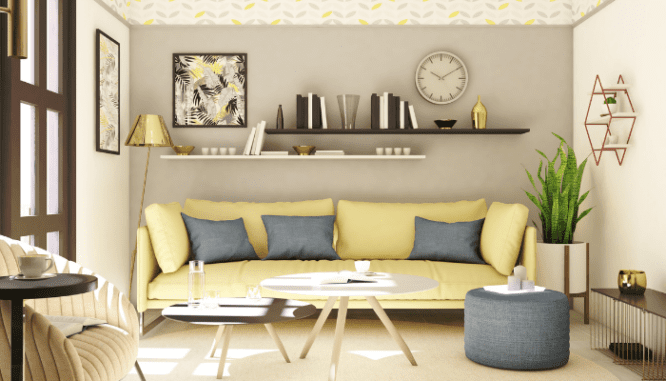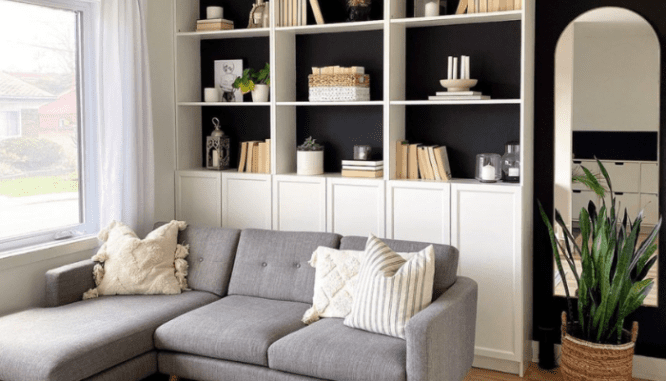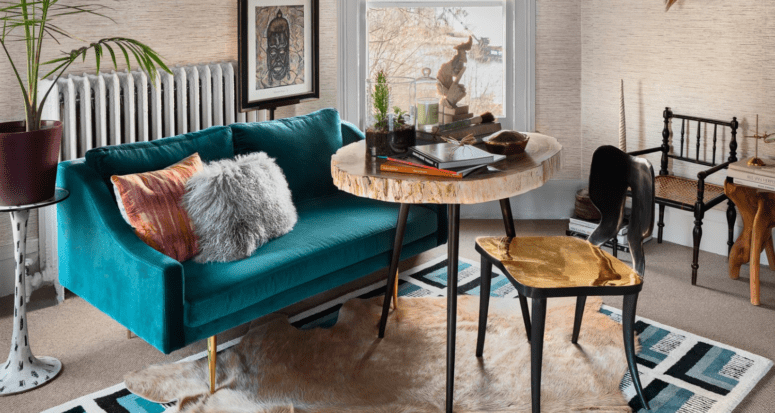11 Clever Small Living Room Ideas from Top Interior Designers
- Published on
- 5-6 min read
-
 Gina Rodrigues Contributing AuthorClose
Gina Rodrigues Contributing AuthorClose Gina Rodrigues Contributing Author
Gina Rodrigues Contributing AuthorGina is a freelance writer and editor who specializes in real estate and personal finance. She brings more than ten years of experience as a licensed agent and property investor. When she isn’t writing, she can be found tending to the sheep and chickens at her suburban homestead outside of Seattle. Gina holds a B.A. in English from California State University.
Can you easily reach out and grab the TV remote from the side table — that’s sitting at the other end of the living room? Or are you contorting like a Cirque du Soleil performer to navigate around the three pieces of furniture in your living room?
Chances are, you have small space problems, and you’re on the hunt for small living room ideas.
While a small room holds certain charms — less to clean, less expensive to decorate, and a cozy feel — it also has its challenges. Balancing space constraints while maintaining a satisfying design aesthetic requires a creative mind.
We asked two top interior designers who specialize in small spaces to share their unique living room solutions:
Rita Melkonian, the creative mind behind Small Space Designer. With a growing Instagram following Melkonian’s profile showcases her penchant for eclectic bohemian design in cozy spaces.
KD Reid, a New Jersey and New York-based designer and stylist with a honed craft for visual storytelling. You’ll find Reid’s work in places such as House Beautiful and HGTV.
When it comes to redesigning a small living space, this is the best thing you can do, according to Melkonian: “Treat your living room as though it is bigger.” Here’s how.

1. Decorate with narrow floating shelves
Taking advantage of shelving not only keeps clutter off the coffee table and adds vertical interest, it also enhances the room’s height rather than its lack of space. To avoid taking up too much space, use narrow shelving 3 to 4 inches deep.
Narrow shelving forces you to keep your shelf decor curated. With limited space, you’ll be less likely to clutter your shelves.
2. Invest in dimmable recessed lighting
“The more natural light available in a room, the bigger and brighter it will look,” says Melkonian. But if your living room isn’t blessed with the sun’s rays, overhead lighting can mimic a bright day. While a hanging light fixture could make a low ceiling appear lower, recessed lighting brightens up the room, making it look more expansive without taking up vertical space. Look for low-energy LED lighting that mimics the color temperature of natural light.
3. Bigger furniture is better — just don’t overdo it
Design newbies make a beeline for petite lounge chairs and undersized side tables when shopping for a small living room. After all, small furniture makes a size-challenged room appear larger, right? Not necessarily, says Melkonian. A cluster of seating options and table groupings tend to make a space look crowded, not open and airy.
Instead of cluttering your living room with several side chairs, select individual anchor pieces that suit the room size, such as a single statement couch and storage ottoman.
Just don’t blow sizing out of proportion. A heavy leather sectional that takes up half the room will look just as cramped as lots of small furniture pieces.
4. Install curtain rods up high
In living rooms that lack ample square footage, airy ceilings spell the difference between a cozy enclave and a stifling cavern. One way to draw the eye upward: install curtain rods well above the window frame. “If you’ve got 8-foot ceilings, hang your curtains as high up as you possibly can,” advises Melkonian.
Installing curtains up high tricks the eye, making the ceiling appear taller and the living room more open than it actually is.
5. Don’t skimp on rug size
Large rugs aren’t cheap, so if you’re going to splurge on something, make it a rug that’s large enough to make an impact. “A rug can make or break your living room,” Melkonian explains. “Rugs are meant to delineate a space, so the smaller it is, the smaller the footprint of the living room will appear.
Shop around for a rug that’s large enough to sit under most of your furniture — your sofa, coffee table, and side table — rather than floating in the middle of the room like a small deserted island.

6. Replace white walls with blues and grays for a sophisticated, jewel-box look
Your first reaction may be to gravitate toward white paint for a fresh, open aesthetic, but there’s no need to shy away from color in a small living room. In addition to the often de facto white found in small rooms, consider painting your walls in sophisticated blue and gray tones, recommends Reid.
Benjamin Moore’s Kensington Blue and Farrow & Ball’s Lulworth Blue provide a vivid, yet soothing backdrop without stifling a room’s size. And while some think that grays visually shrink a space, Reid says the hue has the opposite effect. “[It makes] a small space appear sophisticated but warm and inviting.” When it comes to modern grays, Reid favors Benjamin Moore’s Thundercloud Gray and Farrow & Ball’s Plummett.
7. Paint the ceiling fan the same color as your ceiling
If your ceiling fan looks disjointed with your design style, try painting it the same color as the ceiling, recommends Reid. Matching paint camouflages the fixture instead of drawing attention to it. Blending the fan’s color with the ceiling skews depth perception, which prevents the fan from pulling the ceiling’s visual height down.
8. Convert your living room into a home office with a foldaway desk
Working from home without a dedicated office space? If you’re typing away on the kitchen table because your living room isn’t big enough for a desk, Reid suggests a space-saving solution: a floating desk.
Take Zoom calls from a foldaway office that tucks away at the end of the day, keeping clutter at bay and optimizing your space. During office hours, this streamlined desk won’t cramp your living room style — it takes up little floor space. And when it’s time to clock out, the desk sits out of the way. To further conceal your new home office, Reid suggests hanging artwork or a mirror in front of it.
9. Choose furniture that doubles as storage space
“Storage is key in any small space,” says Melkonian. That’s why Reid recommends multipurpose furniture that doubles as a storage space. A low storage stool or ottoman can serve as a footrest, extra seating, side table, or storage hideaway. The right piece can provide “storage for blankets, pet toys, and even board games,” offers Reid.
10. Don’t be afraid to go bold with wallpaper
Wallpaper has enjoyed a design resurgence in recent years, and small rooms aren’t exempt from the trend. Designer Kyra Hartnett tells MyDomaine that small patterns (or patterns on just one wall) can make a room look smaller. Instead, take a chance by installing large-patterned wallpaper on every wall, which she says will give the illusion of a taller ceiling.

11. Add visual interest (and coveted storage) with a floor-to-ceiling bookcase
“The more you make use of vertical space, the better,” says Melkonian. She recommends pulling the couch forward and away from the wall. Behind it, a floor-to-ceiling bookcase “[adds] depth and interest to the room without taking up too much precious floor space.”
To keep the bookcase decor sleek rather than cluttered, curate your shelf design with select decorative elements such as sculptures, plants, and bookends. Conceal smaller objects not meant for display (think phone charging cables and office supplies) in baskets to keep the space tidy.
Embrace your space despite its size
Short of wielding a sledgehammer to your walls, you may be stuck with limited living room space. But with a splash of creativity and a dose of visual witchcraft, a few strategic design moves can help transform your four confining walls into a comfortable, cozy haven.
Header Image Source: (Ariel Camilo / KD Reid)
